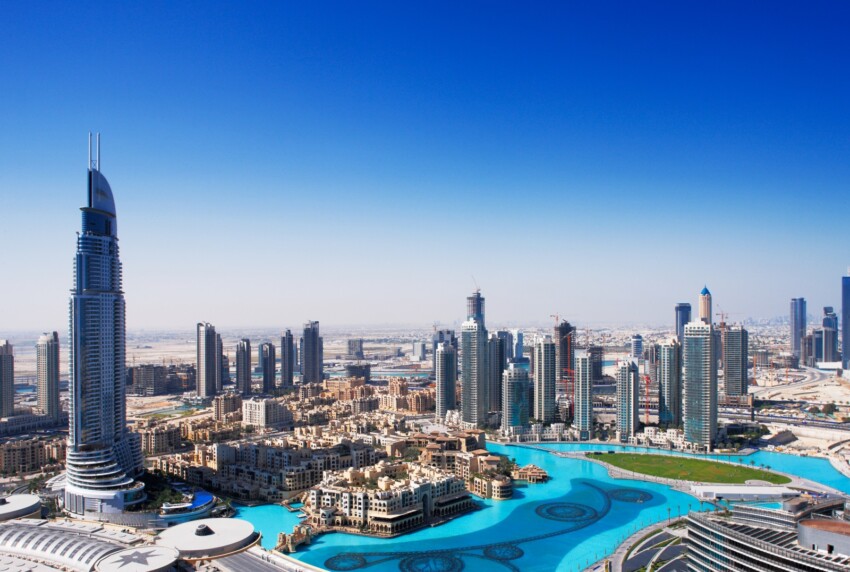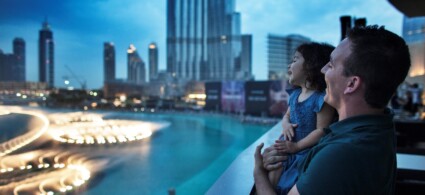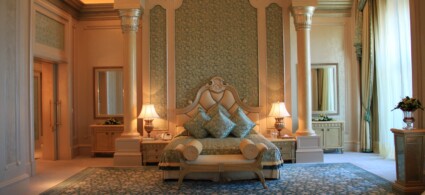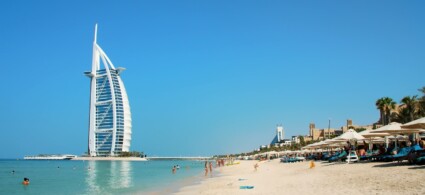

Dubai is the dream of luxury and all things possible. A dream that costs much less than you imagine: thanks to the cost of fuel, which in this area is among the lowest in the world, and the forward-looking airport expansion policy, airlines are able to offer competitive rates for those who want to land in Dubai.
So set off on a mind-blowing journey, where excess is the norm, the impossible becomes real and world records are continually broken.
You can ski even when temperatures reach a dizzying 50°, play golf from the top of a skyscraper, dine in a mega-aquarium with fish passing over and under it, shop in the world’s largest mall, admire a man-made palm-shaped island from the top of a scenic monorail.
Or you can go on a discovery of a lesser-known Dubai, that of the low houses and souks, of the scents of spices and hand-crafted leather.
But leave with one thing in mind: both the modern Dubai of record-breaking skyscrapers and billions and the Dubai of everyday life and traditions will disorient you. Nothing can prepare you for a trip to Dubai because there is nothing else like it in the world.

Dubai is a very special city, totally different from the big European cities we are used to. Don’t expect a historic centre, a main square, a long pedestrian street, museums and ancient monuments; however, it has plenty to see.
Dubai, a futuristic metropolis in the desert, offers an incredible variety of attractions blending modernity and tradition. The 828-metre Burj Khalifa dominates the skyline and offers breathtaking views from the ‘At the Top’ observation platform on the 124th floor. At its foot, the Dubai Mall is not only a shopping paradise, but also houses the impressive Dubai Aquarium with more than 33,000 aquatic animals and the spectacular Dubai Fountain, with its synchronised water games with music and lights.
For a dip into local culture, the historic Al Fahidi district offers a labyrinth of alleys and traditional coral stone houses, where you will also find the Dubai Museum, housed in the 1787 Al Fahidi Fort. Not far away, the colourful gold and spice souks offer a unique sensory experience.
The artificial island Palm Jumeirah is an engineering marvel, with the iconic Atlantis The Palm hotel at its end. Nearby, the sail-shaped Burj Al Arab hotel has become a symbol of extreme luxury. For the adrenaline junkies, a desert excursion offers thrilling 4×4 dune rides, sandboarding and Bedouin dinners under the stars.
The Dubai Frame, a 150-metre-high golden frame, offers a unique perspective on the city, visually connecting old and new Dubai. For relaxation, the Jumeirah Beach Residence and Kite Beach are perfect for sunbathing or water sports. Finally, the Miracle Garden, with its 150 million flowers, and the Global Village, a cultural park celebrating traditions from around the world, complete the offer of this city of superlatives.
Given the amount of tourists who visit these attractions on a daily basis, we recommend that you book tickets for the main attractions online well in advance.
Dubai, a city of contrasts and architectural wonders, offers a unique experience in each of its districts. Each of Dubai’s neighbourhoods offers a unique experience, reflecting the diversity and rapid evolution of this desert metropolis. Whether you are looking for luxury, history, culture or simply relaxation, you are sure to find an area that meets your expectations in this city of contrasts.
The beating heart of modern Dubai, Downtown Dubai is dominated by the iconic Burj Khalifa. Here you will find the gigantic Dubai Mall, the spectacular Dubai Fountain and numerous luxury hotels. The area is perfect for high-end shopping, sophisticated nightlife and admiring the futuristic architecture. Don’t miss the sunset from the rooftop terrace of the Burj Khalifa or an evening stroll around Burj Lake.
This coastal district is a triumph of glittering skyscrapers reflected in the waters of the man-made canal. The Marina is famous for The Walk, a lively waterfront promenade full of restaurants, cafes and shops. Enjoy a dhow cruise, visit the Beach and Marina Mall or relax on the beaches of JBR. At night, the many rooftop bars offer breathtaking views of the illuminated skyline.
A masterpiece of engineering, Palm Jumeirah is an artificial palm-shaped island and a symbol of luxury and ambition. It is home to world-class resorts such as theAtlantis, with its water park and aquarium. Private beaches, restaurants by starred chefs and exclusive villas make it a favourite destination for high-end tourism. Don’t miss a panoramic view from the monorail that connects the mainland to the tip of the island.
The historical and commercial heart of Dubai, Deira offers a dip into the traditional atmosphere of the Emirates. Its famous gold and spice souks are a riot of colours, scents and authenticity, where you can immerse yourself in the local bargaining experience. The district is dotted with historic mosques such as the Grand Mosque of Deira and the Al Ras Mosque. Don’t miss a stroll along the Deira Corniche, from where you can watch the traditional dhows go by on the Creek.
An upmarket residential area, Jumeirah is famous for its public beaches and the iconic Burj Al Arab. The Jumeirah Mosque, one of the few open to non-Muslims, offers guided tours to discover Islamic culture. The area is ideal for relaxing at the beach, shopping at local markets such as Souk Madinat Jumeirah and enjoying international cuisine at the many fine restaurants.
Bur Dubai, located on the western bank of the Dubai Creek, is a fascinating mix of history and modernity. This district is home to some of the city’s oldest sites, including Al Fahidi Fort, which houses the Dubai Museum, offering a glimpse into pre-petroleum life in the Emirates. Don’t miss Sheikh Saeed Al Maktoum Palace, a splendid example of Arabic architecture, and the colourful Hindu Lane area with its temples. In Bur Dubai, take a trip to Al Bastakiya, the historic quarter and an oasis of tranquillity in the heart of the bustling city.

Dubai is a great starting point for exciting excursions in the surrounding area. A tour from Abu Dhabi is a popular option, allowing you to visit the majestic Grand Mosque and the Louvre Abu Dhabi. A desert safari is a must, with dune bashing, Bedouin dinners and shows under the stars. TheAl Ain oasis, a UNESCO World Heritage Site, offers a dive into the culture and history of the Emirates. For adventure lovers, a trip to the Hatta Mountains promises hiking, kayaking and mountain biking.
A day cruise to Musandam in Oman offers spectacular fjords and dolphins. For a unique experience, a sunrise hot-air balloon flight over the desert offers breathtaking views. Finally, a visit to the Sharjah Heritage Area reveals traditional Islamic art and culture.
The only easy way to reach Dubai is by plane: by land or sea would be complicated, expensive and in some cases even dangerous because of some borders to cross. The only safe and attractive alternative to flying is a cruise.
Even if you have to travel with scheduled and not low-cost airlines, flights to Dubai are cheaper than flights to equidistant destinations.
In addition toDubai International Airport, you can also consider Abu Dhabi or Sharjah.
Dubai is a huge city, so before you start looking for a hotel, it’s a good idea to decide which area to stay in. The choice is dictated by several factors such as holiday budget, what you want to see and do, and flight schedule.
Deira is the recommended area for those who want a mid-range hotel and for those who want to experience the most authentic Dubai.
If you want glamour and beaches, head for Jumeirah, a chic neighbourhood where the city’s most luxurious hotels are located. Remember that super-luxury comes at a price, and a lot; moreover, the area is a city in itself compared to the rest of Dubai, more like a giant resort than a neighbourhood.
Other recommended areas to sleep in Dubai are Sheikh Zayed Road, Dubai Marina and the business district.
Getting around on foot in a megacity like Dubai that stretches over 40 km is unthinkable. To visit the city’s tourist attractions you will necessarily have to use public transport and taxis; the good news is that both are efficient and cheap.
Dubai’s public transport network includes metro, buses, trams, sea taxis and a monorail. The metro is ultra-modern, fully automated and currently has two lines, the red (much used by tourists) and the green.
Although the network is extensive and widespread, getting around Dubai by public transport takes a long time due to the huge distances involved. Consider taking a taxi or water taxi.
Dubai’s climate is desert-like, with mild winters (more like a warm spring) and scorching summers that test human endurance. Staying outdoors during the daylight hours of summer days is virtually impossible, which is why travellers to Dubai in July and August end up cooped up in air-conditioned rooms.
It is much better to go to Dubai in winter: you can safely walk around in short sleeves without suffering.
The absolute best time to go to Dubai is over Christmas and New Year’s Eve, but of course on these dates, flight and hotel prices rise sharply.

Dubai is the capital of an emirate of the same name, one of the seven that make up the United Arab Emirates. It lies along the coast of the Persian Gulf, in the Arabian Peninsula, in desert territory. Unlike the other Arab emirates, the Dubai desert is sandy rather than rocky.
The flag of the United Arab Emirates consists of three horizontal stripes of green, white and black (from top to bottom) and a vertical red stripe on the left side.
The four colours together symbolise Arab unity; green is a symbol of fertility, white of neutrality and black of oil wealth.
The current flag has been in use since 1971.
The currency in use in Dubai and throughout the UAE is the dirham, officially abbreviated to AED (Arab Emirates Dirham) but often referred to on websites and in guidebooks as Dhs or DH.
One dirham is equivalent to about 0.25 euro, but of course this figure is only indicative because exchange rates can vary over time. There are 5, 10, 20, 50, 100, 200, 500, 10000 dirham notes, 1 dirham coins and 1, 5, 10, 25, 50 fils (the ‘cents’ of the dirham).




City Card allow you to save on public transport and / or on the entrances to the main tourist attractions.
